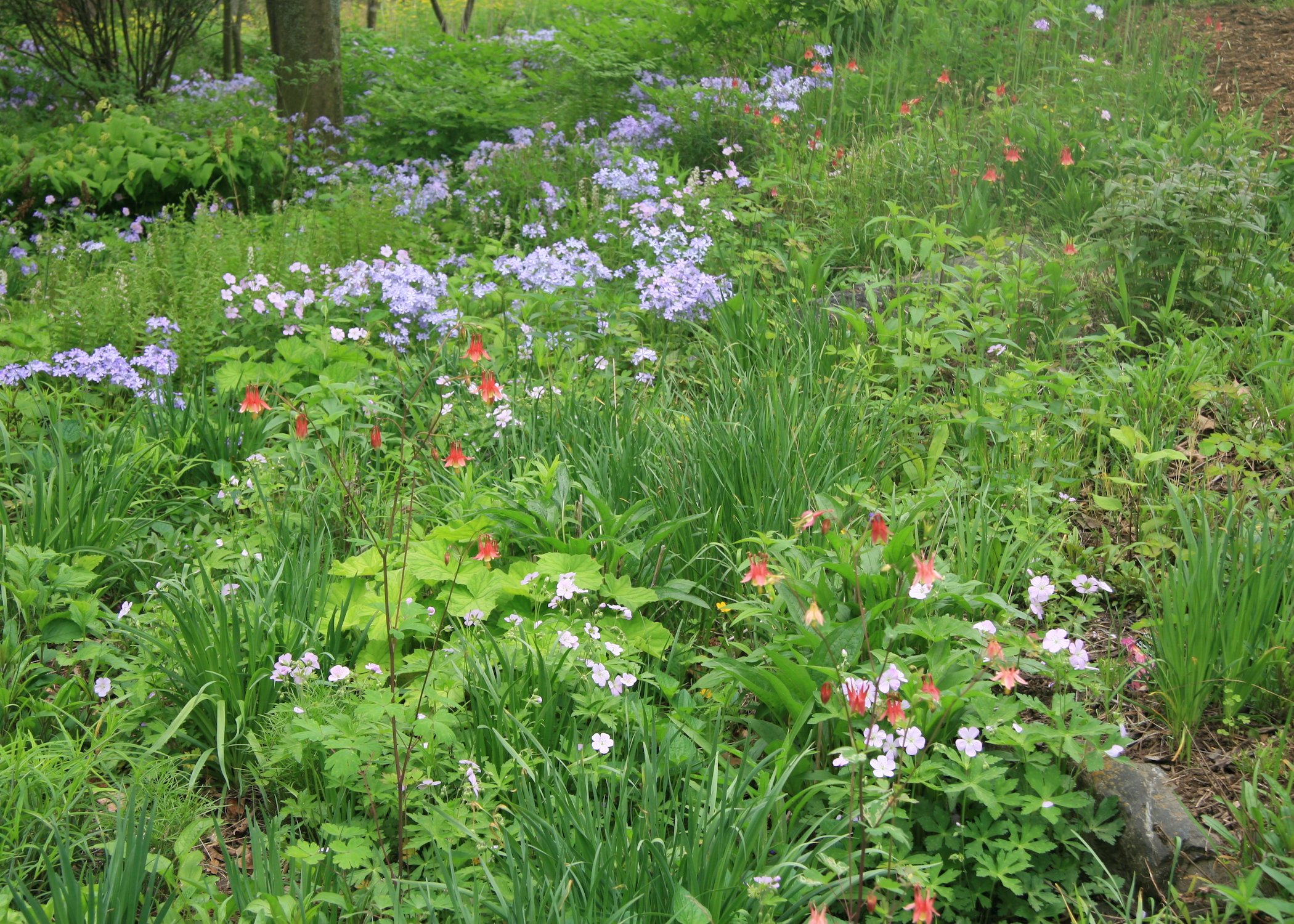Seeding the Woodland Herbaceous Layer: A Multi-year Learning Thread
The three-legged stool of meadow, thicket and woodland form the major temperate North American plant community types. Each contains a different suite of plant species, expresses itself in different spatial patterns and occurs at different stages of ecological succession. While woodlands are considered to be the end of the successional line, their eventual development is not inevitable. Mowing or burning a meadow annually will arrest succession at the herbaceous stage. Removing trees as they emerge through the thicket will prevent a progression to woodland.
In the woods, halting succession is not a concern. Do nothing and you will have a woodland. The interim stages may not be pretty, and the eventual tree composition may not be particularly diverse, but you will have a woodland. Millions of acres of forest have restored themselves after agricultural abandonment without the aid of human planting or management.
Herbaceous species are not as resilient. Research by ecologist Henry W. Art at Williams College in Williamstown Massachusetts showed that long after tree cover had re-established from historic clear cuts, the ferns, sedges, and wildflowers on the ground layer remained depauperate. This was especially true of the specialist species that require very specific environmental conditions such as Trillium spp., Sanguinaria canadensis (bloodroots), Uvularia grandiflora (great merrybells), Cypripedium (lady’s slippers) and many others.
It would seem then that investigating ways to establish woodland herbs on the forest floor would be a worthy exercise. Meadows are mostly planted from seed, so it would stand to reason that woodland ground layers could be planted in the same way. Unfortunately, this is not the case.
White wood aster (Aster divaricatus) and blue stem goldenrod (Solidago caesia) are woodland generalists that can be easily established in a wide variety of woodland conditions.
Most meadow species can be planted with seeds purchased from commercial suppliers. This is due in large part to the fact that their seeds tend to have a long period of viability and relatively simple dormancy requirements (or none at all). Woodland herbs, conversely, tend to be specialists whose seeds have very short periods of viability or very complex germination requirements.
Unlike meadow species, most woodland herbs produce seeds that are encased in fleshy seed coats. The coats deteriorate quickly and the seed either loses viability or additional dormancy requirements come into play. These requirements can be complex; the seed can take years to germinate, if ever. This means that by the time commercially purchased seed has been collected, stored, shipped and planted, the seed coat has dried out and the seeds are no longer viable or will have difficulty germinating.
This has huge practical ramifications regarding the establishment of herbs in the woodland ground layer. If seeds can’t be planted from commercially purchased seed and filling the forest with live plants is not feasible financially, what other options are there? One option entails planting small “mother colonies” of live plants throughout the woodland and allowing them to seed themselves. In this scenario, seeds are hitting the ground exactly when they have evolved to do so. This allows seed coat deterioration and seed germination to occur when moisture levels, temperatures and other requirements are correct.
But while plants are patient, humans are not. How can we increase the speed with which full colonization of a woodland takes place? By lightly disturbing the soil adjacent to the mother colonies you can increase the germination rate of the seeds disbursed from those colonies, thereby increasing the rate of expansion. Colonization can be further sped up by collecting seed from the original colonies, disbursing them into other areas and lightly disturbing the soil to increase germination. This should be done during the time when seeds are being deposited from the source plants, helping to ensure that the planting time is based on the ecology of the plant, not the project’s construction schedule.
Golden groundsel (Packera aurea) expands rapidly by its clonal root system and can form a weed-suppressive ground cover in a moist woodland.
This process plays out over time, of course, which runs counter to traditional landscape practices where the planting sequence is mostly “one and done” and “on to the next project”. This divergence is one that continually emerges when attempting to move from traditional landscape practice to an ecological process-based approach.
But understanding and incorporating ecological process is a challenging intellectual endeavor; we will never learn all there is to know. Gifted ecologist Frank Egler once wrote, “Nature is not more complex than we think. It is more complex than we can think.” Ecology-minded practitioners might find this discouraging, but if we learn as much as we can about the inner workings of wild plant assemblages and creatively incorporate that knowledge into our landscape applications, nature may just complete the picture.
The educational process that leads to a deeper understanding of ecological process is multi-faceted. Observing nature, reading, landscape experimentation and many other avenues can be helpful. But in my experience, discussing a puzzling landscape observation with a colleague can be the most fruitful.
Columbine (Aquilegia canadensis) will be competed out by more aggressive woodland phlox (Phlox stolonifera), nodding onion (Allium cernuum) and other woodland herbs. It will serve as a seed source, however, for colonization into unplanted areas.
One such discussion occurred while I was writing this article. I had just completed the portion that describes planting “mother colonies” of native herbs as a seed source for their eventual colonization. One plant that we have often included in these planted assemblages is Phlox divaricata (woodland phlox), but it rarely reproduced. I decided to call Ian Caton, fellow designer, native plant grower and general plant genius, to discuss this puzzle. Ian informed me that at his property, Wood Thrush Nursery in Floyd, Virginia, woodland phlox seeds readily into the surrounding landscape. I then realized that it also seeds readily at The Mt. Cuba Center for the Study of Piedmont Flora in Hockessin, Delaware, a stunning woodland garden. Why is the plant operating so differently on my landscape projects than on their properties?
Ian noted that in my projects we are usually planting asexually propagated clones, since that’s all the nursery trade has available. At his nursery, only straight species are grown. He also mentioned that there is a wild population of woodland phlox near Mt. Cuba. That population could easily have served as a seed source for the original plants that were installed when the garden was first being developed in the 1940s. If so, their plants would likely also be seed-grown and straight species.
Plant genius Ian Caton contributed to an enlightening conversation with Larry Weaner about woodland phlox (Phlox stolonifera) and its cultivars.
It’s possible that the cultivars I was using on my projects were not producing viable seed. I responded, however, that there is no reason to believe that woodland phlox clones, which are primarily selected for flower characteristics, would be inherently unable to produce viable seed. But then I realized that another characteristic of asexually produced cultivars may explain our dilemma: lack of genetic variability. Because they must be propagated asexually, individuals of the same cultivar have the exact same genetics. But why would that affect seed production?
If woodland phlox happened to be a self-sterile species, successful pollination within a single cultivar planting would be impossible. Individuals of self-sterile species cannot pollinate themselves. They can only successfully accept pollen with a different genetic composition than their own, meaning another individual of the same species. In this scenario, genetic variability within the population is essential and my cultivar plantings had none. Same genetics, no pollination. No pollination, no seeds.
Researching the botanic literature on woodland phlox revealed that it was in fact self-sterile. Consequently, it would make sense to plant multiple cultivars as is done with Vaccinium corymbosum (highbush blueberry), another self-sterile species. Theoretically, this would provide the genetic diversity needed for pollination and seed formation.
Maidenhair fern (Adiantum pedatum), hairy alumroot (Heuchera villosa) and other calcerous woodland herbs quickly form a dense, intermingled cover due to their adaptability to high pH, limestone-derived soils.
Or we could just use straight-species plants grown from seed. The multi-coloured cultivars of woodland phlox are useful in a highly designed garden bed; but for colonizing a woodland, the iridescent blue of the straight species is fine. In fact, if I had to choose between woodland phlox that came in every color on a paint chip ring or one that self-proliferates, I would easily take the latter.
It is entirely possible that neither Ian nor I would have followed the same analytical thread or arrived at the same conclusion alone. A cross-pollinating discussion about cross-pollination resulted in a potential strategy to better establish woodland wildflowers, not only for woodland phlox, but all self-sterile, herbaceous plants.
More than 20 years ago I learned a valuable lesson about the importance of woodland herb establishment from Professor Henry Art and his research at Williams College. Many investigations, observations and discussions have built on that knowledge since, the latest installment of the learning thread being my discussion with Ian.
The next step is to field test our woodland phlox theory in real-world landscapes. The learning process continues.
Originally published by North American Native Plant Society in 2019.





